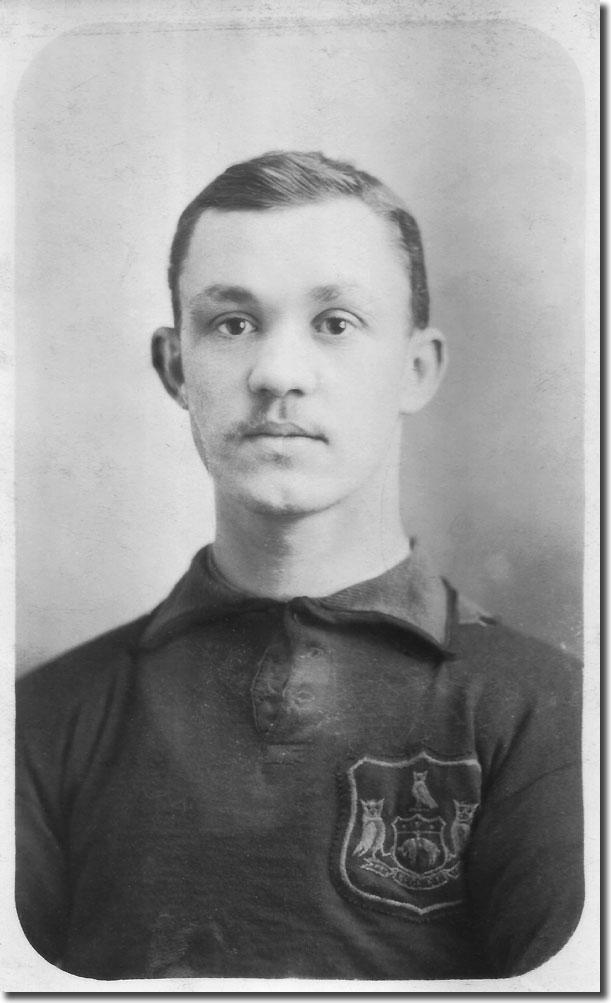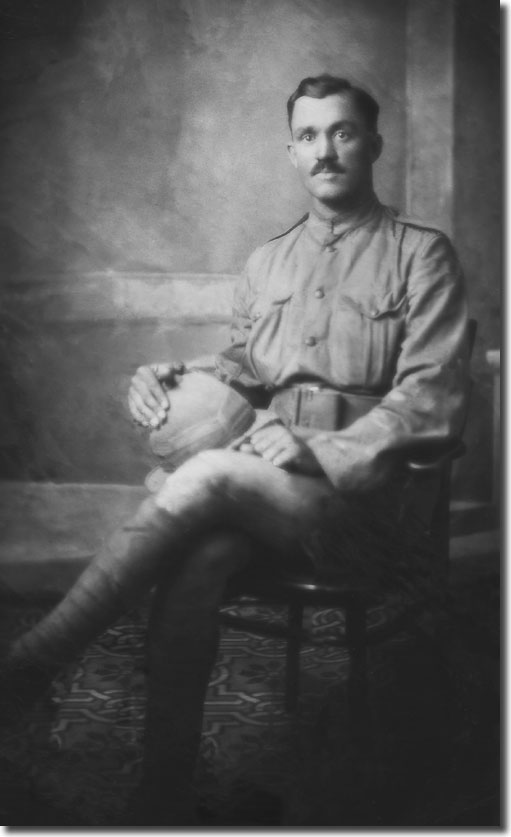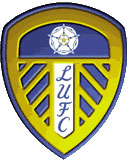 Born:
Leeds, 18 October 1887
Born:
Leeds, 18 October 1887
John 'Jack' Morris showed great potential as a schoolboy and figured
at centre-half for Leeds Schools, relying on his already burly frame to
dominate opposing forwards. He was also a telented cricketer.
Morris harboured high hopes of a glittering future in the professional
game and was looking around for a club who would give him a chance. He
seemed to have struck lucky when his local club, Leeds City, was elected
to the Football League in May 1905. The club had spent the season just
ended in the West Yorkshire League but needed to reinforce its playing
strength to compete in Second Division football. Their recruitment policy
was built in the main on bringing in players from other clubs and Morris
was one of the few local players who made it into the club's first-team
pool. He was delighted to sign up when secretary- manager Gilbert
Gillies offered him a contract in October 1905 on the occasion of
his eighteenth birthday. It made him one of the youngest players in the
squad and Morris was signed in teh expectation that he would play in the
second team and offer cover for the seniors. Morris felt that he was good
enough to force his way into the club's senior side, though he recognised
it might take some time.
Mainly because of his youth and inexperience, Morris spent most of that
first season in City's reserves but was given a break when regular pivot
Harry Stringfellow sustained an injury.
Morris was given his first-team debut on New Year's Day, 1906, in a Second
Division fixture at Blackpool. He did well enough in the 3-0 victory and
figured in each of the eight games that followed though he pulled up no
trees.
The comment in the Leeds Mercury after the 17 February defeat
of Port Vale was pretty typical: 'At half-back, J Morris, in his quiet,
unassuming style, got through a great deal of work.'
Just when he seemed to have established a place in the City side, Morris'
season was ended on 24 February at Barnsley. The Mercury: 'Early
in the match, Morris received injuries both to the knee and ankle, and
for twenty minutes before the interval he was off the field. Subsequently
he returned, but he was to all intents and purposes a passenger, for he
could not assist in checking the movement of the dashing Barnsley forwards.'
It was a cruel blow for a youngster who was desperately keen to make a
future for himself in a game he loved.
Happily, City retained Morris for the
following campaign and he had high hopes that he would yet make a
real fist of his opportunity. The selection committee found a place for
him in the opening game against Bradford City, though he was asked to
switch over to right-half. But this was by no means a happy return - Flaneur
reported for the Leeds Mercury on a less than satisfactory display
by the entire half-back line of Morris, John George
and Jimmy Kennedy: 'The half-back line
was the worst department. Morris and George changed places in the second
half, but neither this couple nor Kennedy showed such form as characterised
the opposition. There was an entire lack of combination between them and
their forwards.'
Nevertheless, it was a combination of George, Morris and Wilson that
created the opening for Jack Lavery to equalise in the last five minutes
with 'a low, slow shot' which caught the goalkeeper napping. This was
no mean feat as the keeper in question was the legendary Willie 'Fatty'
Foulke.
Matters had not been helped when the luckless Morris sustained another
injury in the game and had to limp through the second half. He gave way
to George in the next match with Fred Walker returning at centre-half.
City's long-term solution was to instate Fred
Hargraves at right-half and he filled the berth for the remainder
of the season.
back to top
The injury to Morris was more serious than initially thought and he spent
the rest of the season on the sidelines. At the end of the season, he
was given the news he had long been dreading - he would not be retained
by the club. He dropped into non-league football with Heckmondwike but
a year later signed for the newly-formed . His time there was not particularly
successful and he moved on to Mirfield United in November 1909. Morris
joined Wath Athletic in October 1910 and remained with them until the
outbreak of war, when he enlisted for the Army.
He saw action in Mesopotamia (modern-day Iraq) during a four-year conflict
between the Allied Forces and the Turks, who were aligned with the Germans.
The conflict ended in November 1918, 15 days after the Armistice and one
day after the occupation of Istanbul.
On 23 October 1914 British Indian Army troops, who were already in Bahrain
to protect the oil refineries, invaded southern Mesopotamia and advanced
up the Tigris Valley. They soon captured the important city of Basra. Turkish
attacks were repulsed, and late in 1915 the British advanced again through
Kut-el-Amara and on north towards the Mesopotamian capital of Baghdad. By the end of the year, Major-General Charles Townshend, who had taken
over command of operations, found himself besieged in Kut.
By the end of the year, Major-General Charles Townshend, who had taken
over command of operations, found himself besieged in Kut.
The siege was a drawn-out affair and the men of the 6th Division were
surrounded for five months under fire from all sides. They had to fight
off several attempts to storm the town by the Ottomans, with dwindling
resources in conditions of increasing desperation and deprivation. Townshend
began to fall to pieces when he realised that he would not take Baghdad
after all.
Townshend could have retreated back to Basra if he had wanted to do so,
but instead he chose to make his stand at Kut. The decision was taken
to allow him to come out of the campaign as a hero, though Townshend claimed
that his men were exhausted and could not march anymore.
During December, General Nureddin Pasha advanced and on Christmas Day
seized part of the old fort there before fierce British counter-attacks
drove them out.
The tactics now changed to attrition as the enemy decided to starve Townshend's
forces into surrender.
In late April 1916, Townshend came up with a desperate plan to bribe
the Ottomans into letting him and his men leave Kut. He surrendered the
town, along with 6,000 Indians and 2,070 British soldiers. A force of
Indians under General Fenton Aylmer had tried repeatedly and unsuccessfully
to relieve Kut, and had suffered over 21,000 casualties. Nonetheless,
by December 1916 the British renewed their advance up the Tigris with
166,000 men - over 100,000 of them Indians. On 11 March 1917 they entered
Baghdad.
1917-18 saw a continued Allied advance northwards through the rest of
Mesopotamia, and on to the Caspian Sea and to the Mosul oilfields. These
were taken over on 14 November 1918, just before the end of the war, at
which time there were reckoned to be 260,000 Indian soldiers in Mesopotamia
– three times as many as the British contingent.
It had taken the Allies four years and cost 80,000 casualties to drive
the Turks out of the Mesopotamian oilfields. Altogether, some 675,000
Indian fighting troops saw service in Mesopotamia, as well as hundreds
of thousands of auxiliary troops. Without the work of the Indian auxiliaries
on the Mesopotamian railways – which supplied almost every requisite for
fighting and for everyday living on campaign – the Allied forces would
never have enjoyed the victory they achieved.
With great thanks to Graham Cole, great nephew of Jack Morris, for
the photographs and some of the background information.











 Born:
Leeds, 18 October 1887
Born:
Leeds, 18 October 1887 By the end of the year, Major-General Charles Townshend, who had taken
over command of operations, found himself besieged in Kut.
By the end of the year, Major-General Charles Townshend, who had taken
over command of operations, found himself besieged in Kut.